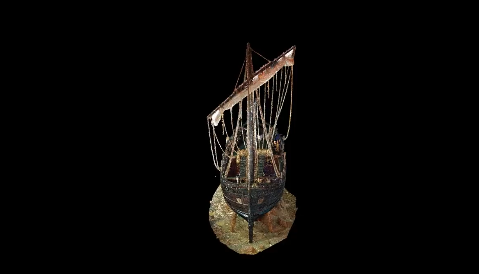Ancient ships are being found with more frequency. History fans are eating it all up as actual historical dates and estimates are now changing the textbooks.
In 1965, the discovery of the ancient Greek ship Kyrenia off the coast of Cyprus unveiled a treasure trove of historical artifacts, including almonds, pottery, and ancient coins. Since its discovery, the ship has provided invaluable insights into the classical world, but its exact age has remained a topic of scholarly debate. A new study published in PLOS One has now refined the ship’s dating, suggesting that it sank around 280 BCE, rather than the previously believed 300 BCE.
Zeroing in on Kyrenia sinking: The @Cornell Tree-Ring Laboratory identified the likeliest timeline of the Hellenistic-era ship’s sinking as between 296-271 BCE, with a strong probability it occurred between 286-272 BCE. @CornellCAS @PLOSONE https://t.co/SL8FQ5Zy25
— Cornell Chronicle (@CornellNews) June 26, 2024
Sturt Manning, a professor at Cornell University and the lead author of the study, highlighted the significance of the Kyrenia shipwreck. He described it as a pioneering find that demonstrated how artifacts from the classical era could be preserved under the sea for over two millennia. According to Manning, shipwrecks serve as “unique time capsules” that offer exceptional preservation of historical materials.
The research team employed updated radiocarbon dating techniques, which involve measuring the decay of specific carbon isotopes within organic material. This method, however, can be impacted by fluctuations in atmospheric carbon levels over time. To enhance accuracy, the team calibrated their carbon dating results against a newly developed dataset of tree ring samples from the Northern Hemisphere. This allowed for more direct and precise age assessments.
Additionally, the researchers devised a novel method to remove polyethylene glycol from the artifacts. This preservative, commonly used by curators in the 20th century, can interfere with modern radiocarbon dating techniques. The removal of this substance was crucial in enabling more accurate dating.
The implications of this updated dating are significant, extending beyond the Kyrenia shipwreck itself. The revised tree ring dataset, covering the period from 400-250 BCE, is expected to aid in more accurately dating other archaeological finds from this era across the Northern Hemisphere. Manning noted that the recalibrated radiocarbon curve could impact a wide range of research, affecting studies in regions as diverse as Europe and China.
The #Kyrenia is a Hellenistic era merchant ship that sank off the coast of northern #Cyprus. It was excavated from 1967-69, as one of the earliest #shipwrecks to be excavated scientifically by a team of underwater archaeologists pic.twitter.com/DvIkiqnYr0
— Brita Lorentzen 🔬🌲 (@dendrobel) June 26, 2024
The study not only refines the dating of the Kyrenia shipwreck but also enriches our understanding of the ship’s historical context. Manning emphasized how classical texts and archaeological discoveries at port sites had already established the importance of maritime trade during this era, which he referred to as an early period of globalization. The Kyrenia ship, which was likely about 15 meters long and manned by a crew of four, provides a vivid glimpse into the practical aspects of maritime trade that flourished in the Mediterranean from Greek through Late Antique times.
Major Points:
- The ancient Greek ship Kyrenia, discovered off the coast of Cyprus in 1965, has been redated to approximately 280 BCE, slightly younger than previously believed.
- A study published in PLOS One used advanced radiocarbon dating methods, calibrated with a new Northern Hemisphere tree ring dataset, to determine the ship’s more accurate age.
- Researchers developed a technique to remove polyethylene glycol, a preservative that interfered with traditional dating methods, enhancing the accuracy of their findings.
- The study’s implications extend beyond the ship itself, as the updated tree ring data can improve age estimates for other archaeological finds from 400-250 BCE across the Northern Hemisphere.
- The Kyrenia shipwreck offers vital insights into the maritime trade and cultural connections across the Mediterranean during an early era of globalization.
Conner T – Reprinted with permission of Whatfinger News



